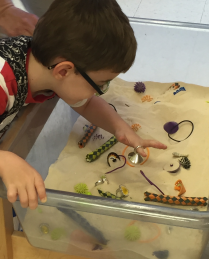
Supporting Sensory Processing Skills
 Sensory processing is how an individual organized and responds to information coming in through the 5 senses-visual, tactile, auditory, olfactory, and orally. Individuals with sensory processing issues can have sensory hypersensitivity and find sensory information overwhelming--noises too loud, lights too bright or a room too visually busy, or be bothered by textures in their environment or from their clothing. Conversely, some individuals with sensory processing challenges have sensory hyposensitivity and crave sensory input and are sensory seeking. Many individuals with sensory processing issues can demonstrate both ends of the continuum, depending on the circumstance and the sensory input. Body awareness or proprioception and spatial orientation or the vestibular sense are also often impacted in individuals with sensory processing needs. Providing a range of sensory opportunities that can be sensory alerting and/or calming helps individuals regulate the information coming in through their senses.
Sensory processing is how an individual organized and responds to information coming in through the 5 senses-visual, tactile, auditory, olfactory, and orally. Individuals with sensory processing issues can have sensory hypersensitivity and find sensory information overwhelming--noises too loud, lights too bright or a room too visually busy, or be bothered by textures in their environment or from their clothing. Conversely, some individuals with sensory processing challenges have sensory hyposensitivity and crave sensory input and are sensory seeking. Many individuals with sensory processing issues can demonstrate both ends of the continuum, depending on the circumstance and the sensory input. Body awareness or proprioception and spatial orientation or the vestibular sense are also often impacted in individuals with sensory processing needs. Providing a range of sensory opportunities that can be sensory alerting and/or calming helps individuals regulate the information coming in through their senses.
Being proactive and providing students a regular set of sensory activities throughout the day, often known as a sensory diet is one way to help students be more successful in their day.
Sensory Break: Sensory and movement breaks are important for all students--not just those with sensory processing needs and can be incorporated easily into the school day with simple supports such as sensory breaks. Use the dial activity below to provide students with a way to rotate through a variety of activities during a sensory break.
Sensory Stations: Sensory stations can be set up in a classroom or a therapist’s room for either a formal sensory-motor activity or for students to self break from desk work as needed.
Food Exploration: Often students with sensory processing challenges are also picky eaters. Use this sequence strip to remind students of the steps they need to take to when trying new foods.
Sensory Bins: Sensory bins filled with beans, sand, rice or even buttons (buttons are easy to disinfect during cold and flu season!) are a great strategy for providing students with a sensory experience. Bury picture cards that are aligned with a classroom theme or a student’s favorite topic and have them hunt for an engaging activity.
Occupational Therapy #OT
 Facebook
Facebook Twitter
Twitter Pinterest
Pinterest